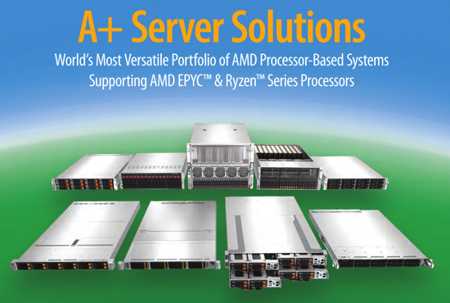Availability of Supermicro H13 AMD Based-Systems with Support for 4th Gen EPYC Processors
Including H13 Hyper-U, H13 all-flash EDSFF, H13 GPU-optimized systems, H13 Hyper, H13 CloudDC, and H13 GrandTwin systems
This is a Press Release edited by StorageNewsletter.com on June 19, 2023 at 2:01 pmSuper Micro Computer, Inc. announced that its line of H13 AMD based-systems is available with support for 4th Gen AMD EPYC processors, based on ‘Zen 4c’ architecture, and 4th Gen EPYC processors with AMD 3D V-Cache technology.
The company’s servers powered by 4th Gen EPYC processors for cloud-native computing, with thread density and 128 cores/socket, deliver rack density and scalable performance with energy efficiency to deploy cloud native workloads in more consolidated infrastructure.
These systems are targeted for cloud operators to meet the growing demands of user sessions and deliver AI-enabled new services. Servers featuring AMD 3D V-Cache technology excel in running technical applications in FEA, CFD, and EDA. The large Level 3 cache enables these types of applications to run faster. Over 50 world record benchmarks have been set with EPYC processors over the past few years.
“Supermicro continues to push the boundary of our product lines to meet customers’ requirements. We design and deliver resource-saving, application-optimized servers with rack scale integration for rapid deployments,” said Charles Liang, president, and CEO, Supermicro. “With our growing broad portfolio of systems fully optimized for the latest 4th Gen AMD EPYC processors, cloud operators can now achieve extreme density and efficiency for numerous users and cloud-native services even in space-constrained data centers. In addition, our enhanced high performance, multi-socket, multi-node systems address a wide range of technical computing workloads and dramatically reduce time-to-market for manufacturing companies to design, develop, and validate new products leveraging the accelerated performance of memory intensive applications.“
“4th Gen AMD EPYC processors offer the highest core density of any x86 processor in the world and will deliver outstanding performance and efficiency for cloud native workloads,” said Lynn Comp, corporate VP, server product and technology marketing, AMD (Advanced Micro Devices Inc). “Our latest family of data center processors allow customers to balance workload growth and flexibility with critical infrastructure consolidation mandates, enabling our customers to do more work, with more energy efficiency at a time when cloud native computing is transforming the data center.“
H13 Hyper-U
H13 Hyper-U– The 1U and 2U Hyper-U servers are designed for the high-performance and density for cloud-native workloads such as virtualization and HCI, with a single 4th Gen EPYC processor for cloud native computing of up to 128 cores. In addition, storage-optimized configurations are available that contain either 12×3.5″ drive bays or 24×2.5″ drive bays. Using a single CPU with the Hyper-U may reduce software licensing costs and cooling challenges compared to dual CPU servers while still providing maximum core density and doubling the memory capacity with support for up to 12 channels of DDR5 in 24 DIMM slots.
H13 All-Flash EDSFF
H13 All-Flash EDSFF – The All-Flash NVMe storage systems powered by EPYC 9004 Series processors, based on ‘Zen 4c’ architecture, are designed with the latest EDSFF technologies allowing capacity and performance in a 1U chassis. Taking advantage of 128 PCIe 5.0 lanes, this server supports 16 (7.5mm) EDSFF E3.S drives, or 8 E3.S (x4) drives and 4 CXL devices in E3.S 2T form factor allowing memory expansion for use cases such as in-memory database applications.
In addition, the following enhanced families of H13 systems provide upgrade path compatibility with the new AMD EPYC processors.
H13 GPU-optimized systems
H13 GPU-optimized systems – The open, modular, standards-based servers provide performance and serviceability with a hot-swappable, toolless design powered by dual EPYC 9004 Series processors. GPU options include the latest PCIe, OAM, and NVIDIA SXM technology. These GPU systems are for workloads with the most demanding AI training performance, HPC, and big data analytics.
H13 Hyper
H13 Hyper – 1U and 2U dual-socket H13 Hyper series bring next-gen performance to the company‘s range of rackmount servers, built to take on the most demanding workloads along with the abundant storage and I/O options that provide a custom fit for a range of application needs, as well as providing manageability with its 100% toolless design.
H13 CloudDC
H13 CloudDC – The single-socket H13 CloudDC takes advantage of EPYC processor core density and provides flexibility on I/O and storage with 2 or 4 PCIe 5.0 slots for GPUs and dual AIOM slots (PCIe 5.0; OCP 3.0 compliant) for maximum data throughput. The 1U and 2U H13 CloudDC systems are designed for convenient serviceability with toolless brackets, hot-swap drive trays, and redundant power supplies that ensure rapid deployment and more efficient maintenance in any size data center.
H13 GrandTwin
H13 GrandTwin – The firm’s 2U 4-node system is purpose-built for single-processor performance. The H13 GrandTwin with EPYC 9004 Series processors optimizes the balance between computing performance, memory, and energy efficiency to deliver maximum density in a 2U form factor with 4 nodes in one system. In addition, the H13 GrandTwin features front (cold aisle) hot swappable nodes, which can be configured with either front or rear I/O for serviceability. As a result, the H13 GrandTwin is for workloads such as CDN, multi-access edge computing, cloud gaming, and high-availability cache clusters.
Resources:
Brochure A+ Server Solutions
Supermicro H13 WP
Video: Supermicro New H13 Systems




















 Subscribe to our free daily newsletter
Subscribe to our free daily newsletter

